Introduction
Selecting the right extension ladder is not just about reaching new heights; it's a vital step toward ensuring safety and efficiency for any project. In various industries, from construction to maintenance, the right ladder can significantly impact both the quality of work and the well-being of workers. With a plethora of ladder types available, understanding the key factors to consider—such as height requirements, material differences, and safety features—becomes essential for making informed decisions.
This article delves into the intricacies of choosing, renting, and using extension ladders effectively, offering practical insights that can help businesses optimize their operations while safeguarding their teams. Whether it's about evaluating rental providers or adhering to best practices for ladder use, the following sections aim to equip readers with the knowledge needed to navigate the challenges associated with working at height.
Choosing the Right Ladder Type
Selecting the appropriate type of climbing equipment is crucial for guaranteeing both safety and efficiency on the job. Every assignment has its own distinct necessities, and choosing the suitable step stool can create a considerable impact. For instance, extension platforms are particularly beneficial for reaching elevated areas, making them indispensable for businesses in construction, maintenance, or window cleaning. These steps provide improved access, enabling activities such as painting or roof repairs to be finished effortlessly.
When choosing a climbing tool, it’s important to evaluate several factors, including height needs, stability, and weight capacity. Extension structures, with their adjustable lengths, eliminate the need for multiple designs, providing flexibility for various tasks. They are designed with safety features like non-slip feet and stabilizing bars, which help minimize the risk of accidents. Moreover, their collapsible design makes them easy to store in compact spaces and transport in standard vehicles.
Durability is another vital factor; contemporary climbing devices are made from premium materials to guarantee prolonged use, providing companies a strong return on their investment. By making an informed choice regarding equipment selection, businesses can not only enhance their operational capabilities but also ensure that tasks are performed efficiently and safely.
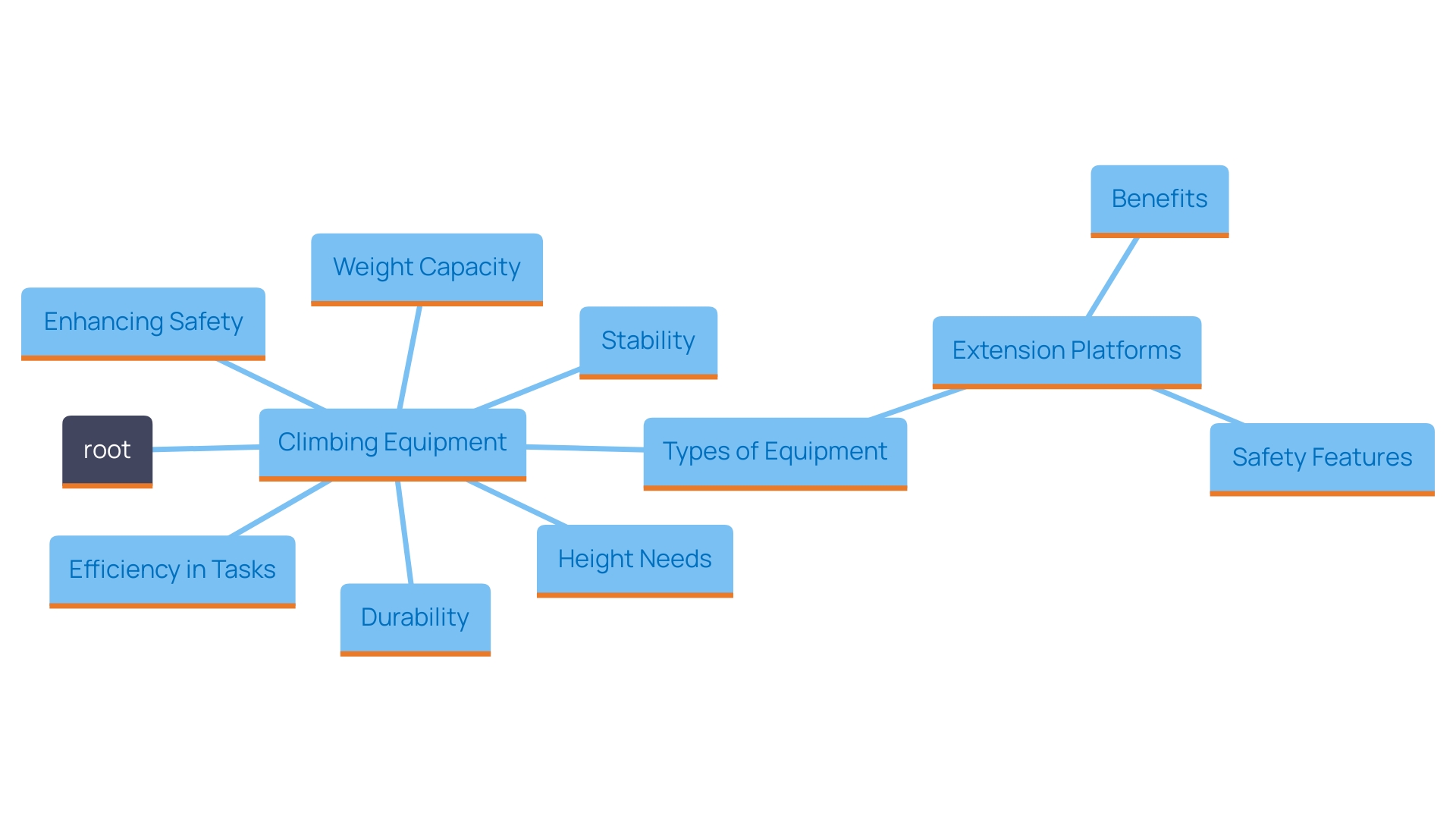
Key Factors to Consider When Renting an Extension Ladder
Renting an extension tool involves careful consideration of several key factors to ensure it meets your specific needs. First, determine the height range required for your projects. 'Extension equipment comes in various sizes, and selecting the right height is crucial for safe and efficient access.'.
Next, consider the structure's material—aluminum or fiberglass—each has its own set of advantages. Aluminum steps are lightweight and easy to maneuver, making them ideal for frequent transportation. Conversely, fiberglass step structures are non-conductive, offering a crucial protective characteristic for electrical tasks, rendering them appropriate for numerous professional uses.
'Weight capacity is another critical aspect; ensure that the equipment can support not only your weight but also any tools or materials you may have while working at height.'. This is especially important for businesses in construction or maintenance, where rigorous use is common.
When assessing extra attributes, search for platforms equipped with locking systems that improve stability during operation, as well as slip-resistant steps which offer increased protection. Contemporary climbing tools frequently include stabilizing bars and non-slip bases, further minimizing the chance of mishaps. By choosing a step structure that meets industry safety standards, you can ensure optimal performance and peace of mind while working at heights.
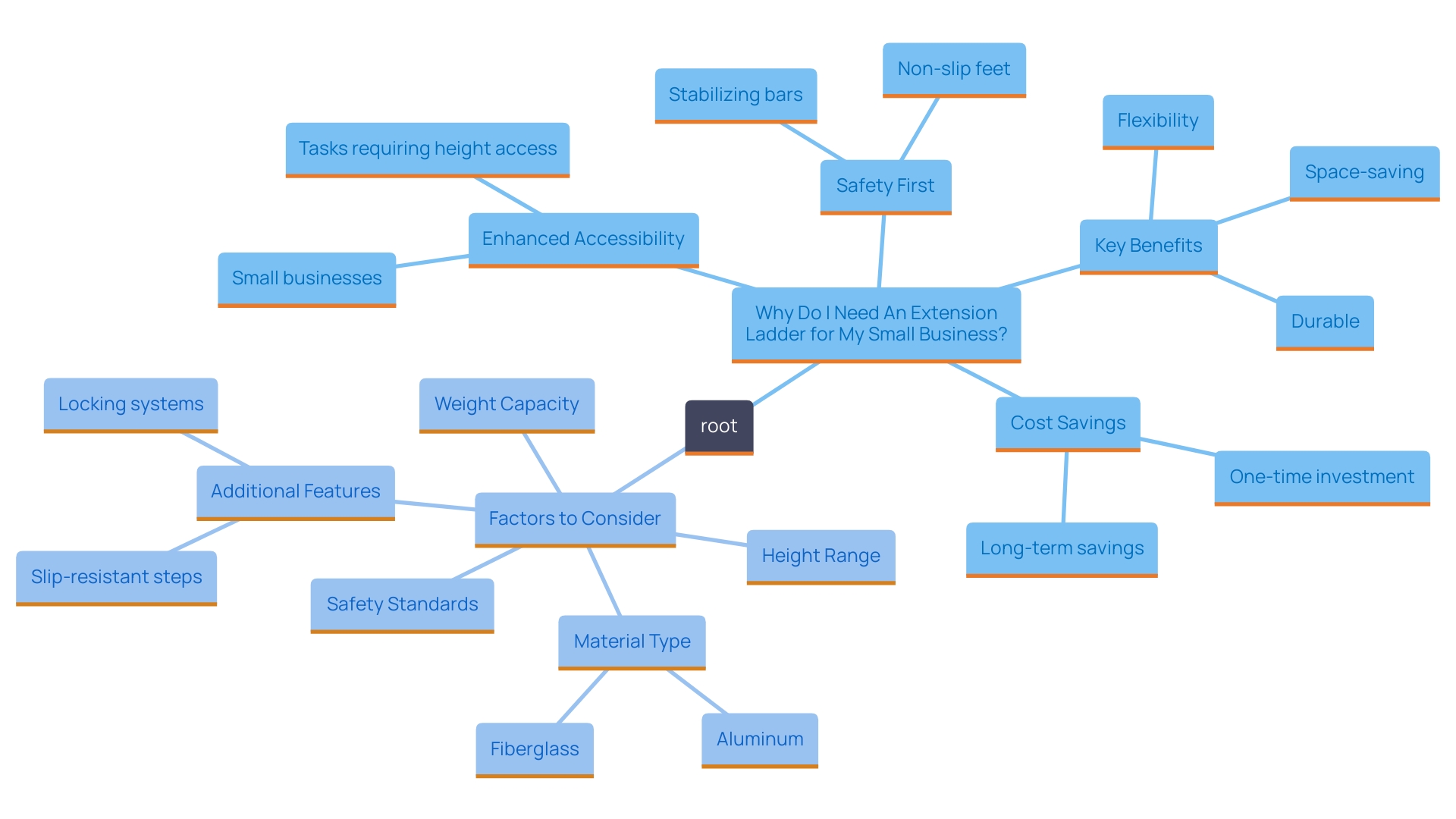
Safety Considerations for Extension Ladders
Safety is a critical consideration when using extension equipment, especially in small business environments where tasks often involve reaching significant heights. Before each use, a thorough inspection of the equipment for any damages or defects is essential. It’s important to set up the climbing device on stable, level ground and position it at the correct angle—approximately 75 degrees—to ensure maximum stability.
Contemporary extension tools are fitted with innovative protective elements, like non-slip bases and stabilizing rods, greatly lowering the chance of mishaps. According to OSHA guidelines, eliminating potential hazards is the best practice for avoiding injuries. This principle applies equally to step safety. By removing unnecessary risks and using personal protective equipment like helmets and harnesses, workers can further mitigate dangers associated with working at height.
Furthermore, the significance of never surpassing the load limit of the equipment cannot be overstated. Overloading can compromise the integrity of the structure, leading to accidents and injuries. With the appropriate safety precautions implemented, telescopic structures can be a versatile and invaluable resource for small enterprises, allowing efficient and safe access to elevated areas for activities such as painting, roof repairs, or maintenance work.
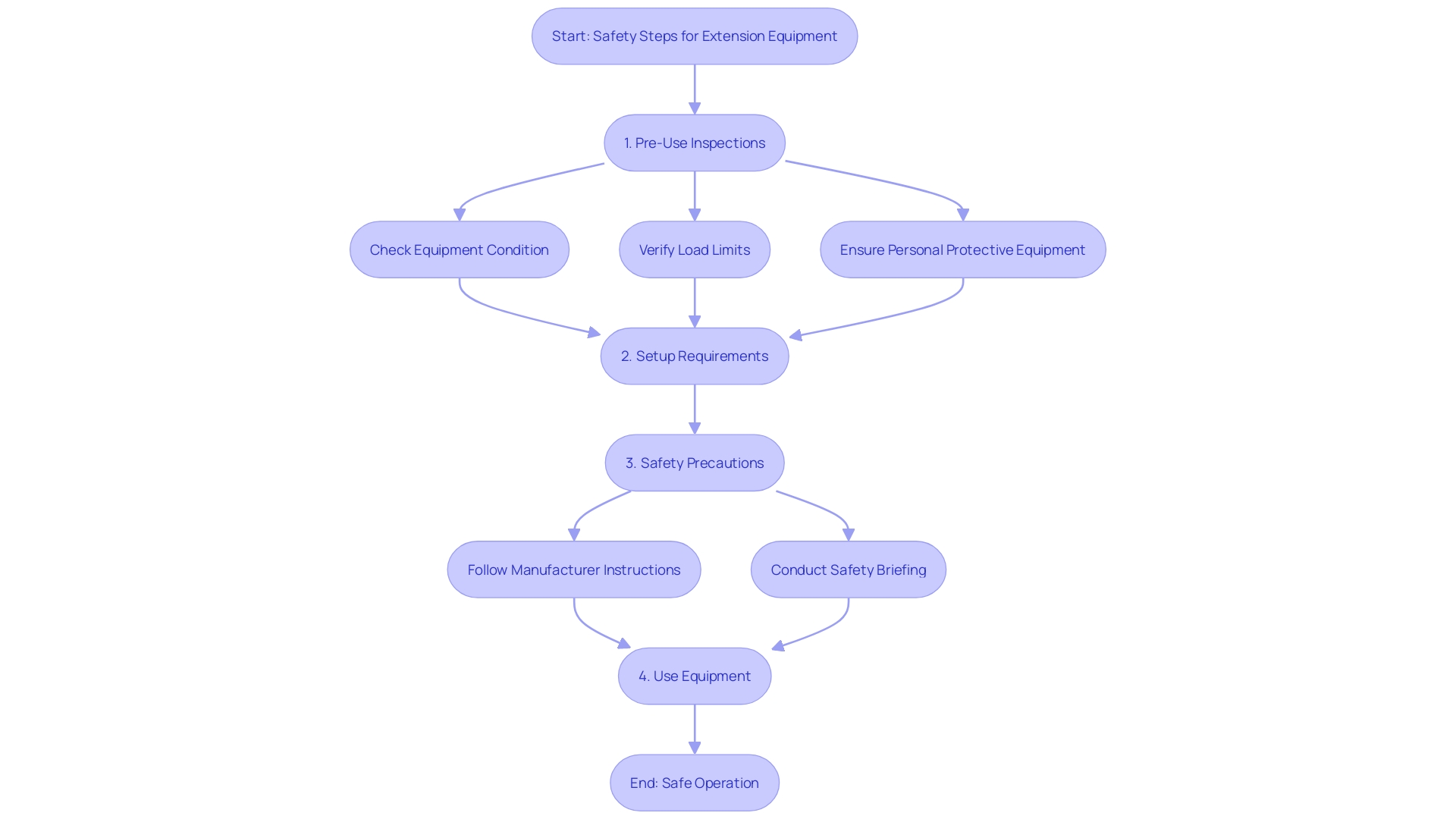
Benefits of Renting Extension Ladders
'Renting extension equipment presents a myriad of advantages that cater to the specific needs of various projects.'. One of the primary benefits is flexibility; renting allows businesses to acquire high-quality equipment only when necessary, avoiding the hassles of maintenance and storage associated with ownership. This is especially beneficial for short-term projects, where spending on such equipment might not be justifiable.
Moreover, renting can be a financially savvy choice. For instance, it eliminates substantial upfront costs and ongoing upkeep expenses, making it an attractive option for companies looking to manage their budgets effectively. In fact, as reported, the resilience in business spending, with new orders for manufactured durable goods increasing by 0.7% in April, underscores the importance of cost-effective solutions in equipment utilization.
Moreover, the construction sector is progressively acknowledging the importance of leased machinery in maintaining security and adhering to regulations. Businesses frequently discover that using leased climbing equipment not only boosts operational effectiveness but also contributes to upholding a robust safety culture on-site. By ensuring access to the right tools without the long-term commitment, businesses can focus on their core activities while also aligning with sustainable practices.
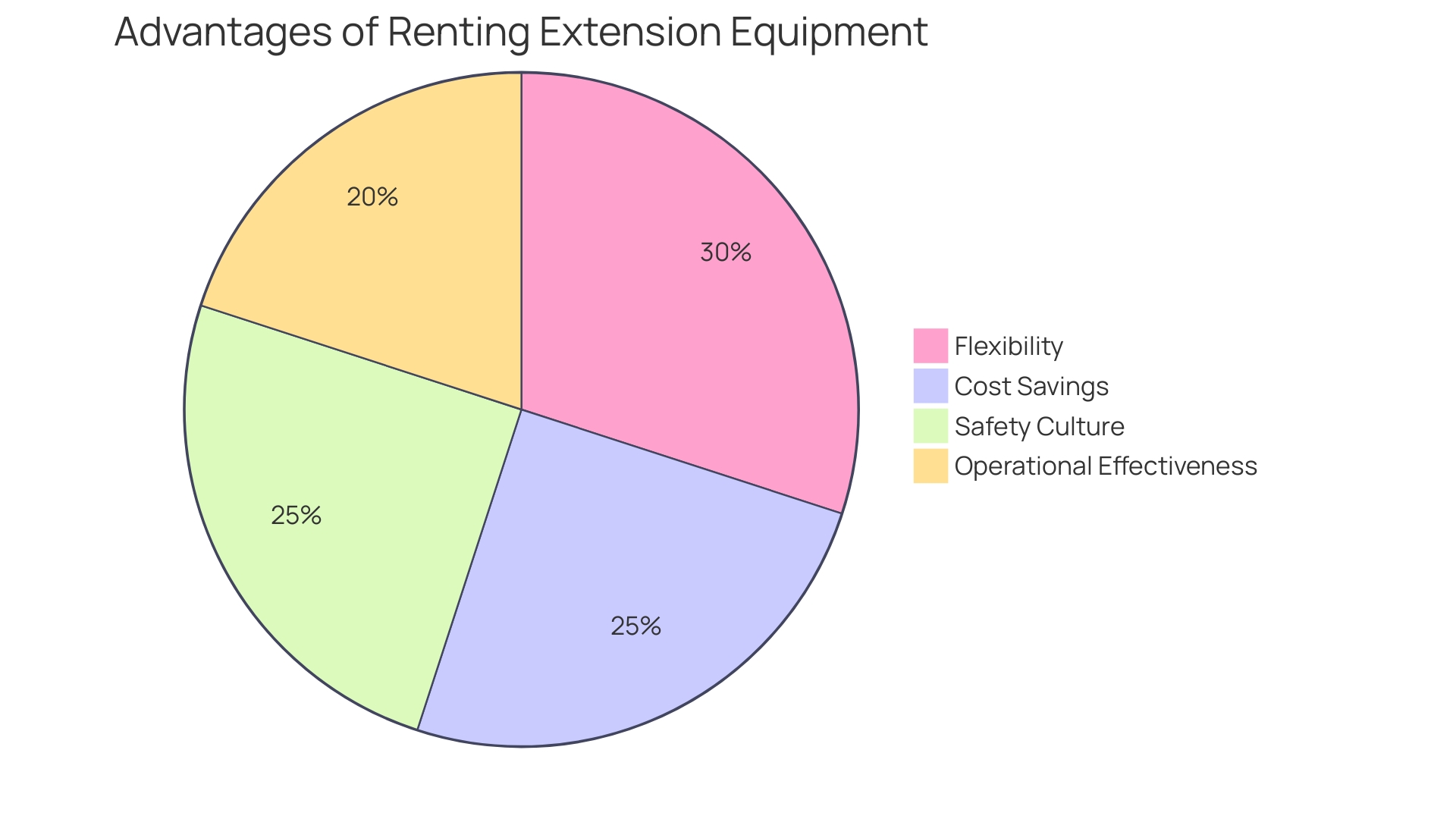
How to Rent an Extension Ladder
Hiring a long reach scaffold involves a few significant steps to make sure you acquire the appropriate gear for your requirements. Start by locating nearby rental services that focus on climbing equipment, as their selections might differ. Take the time to compare prices, availability, and the terms of rental agreements, ensuring you find a provider that fits your budget and schedule.
'Once you've narrowed down your options, reach out to inquire about the specific types of extension equipment available.'. Depending on your project, you may require different heights or features of the equipment. Understanding these options is crucial for ensuring safety and efficiency on the job.
Be sure to thoroughly review the rental agreement. This includes clarifying any required deposits, insurance options, and policies regarding the return of the equipment. Knowing these details upfront can help you avoid unexpected costs and logistical challenges later on.
Extension devices are not merely tools but vital resources for numerous small enterprises, particularly in fields such as construction and maintenance. They improve accessibility for activities that require reaching heights, such as roof repairs or painting. 'With contemporary styles aimed at protection, featuring non-slip bases and stabilizing elements, these structures considerably decrease the likelihood of workplace incidents.'. Putting money into a dependable extension tool can simplify your processes, making sure that activities are performed safely and efficiently.
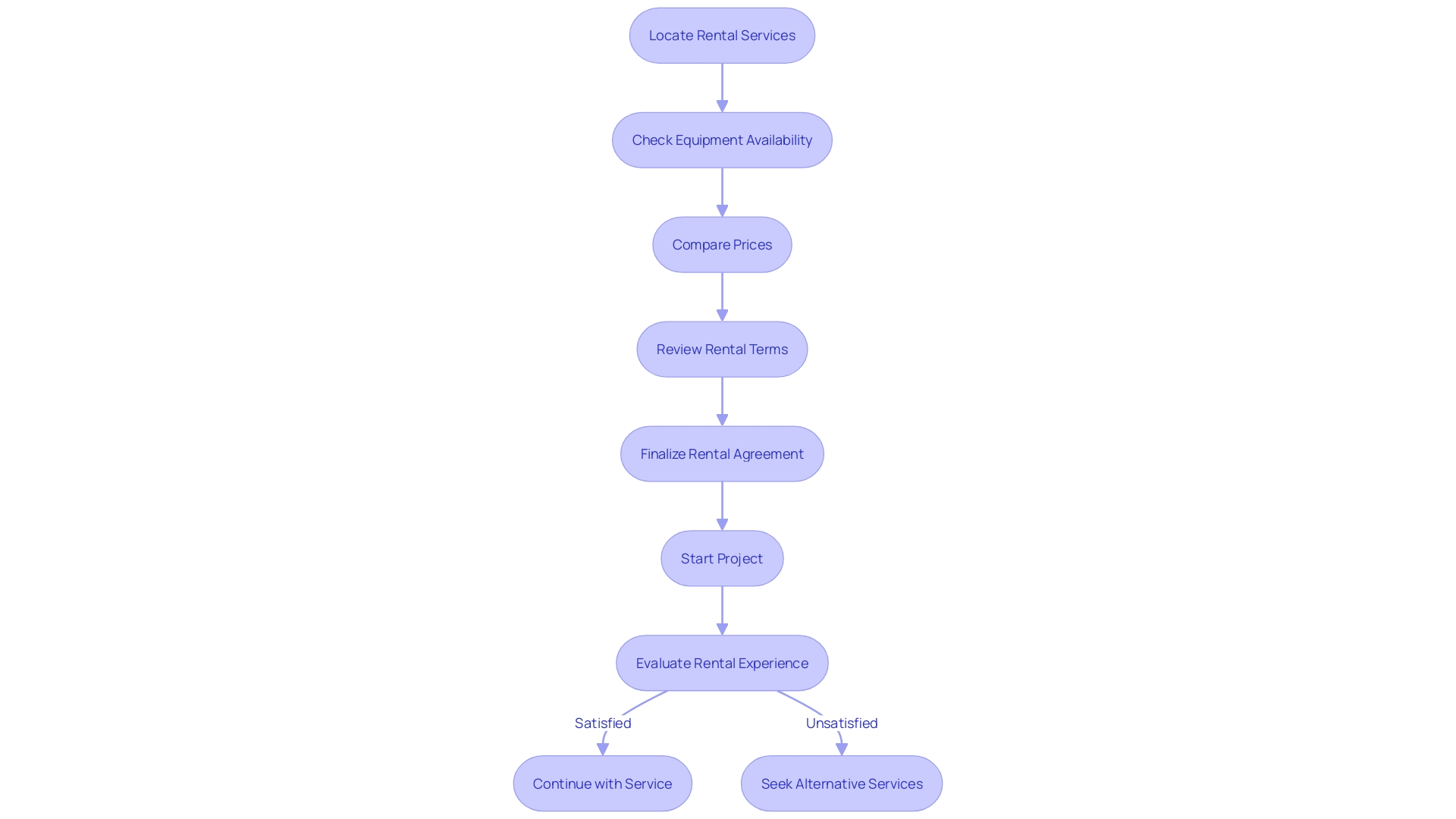
Types of Rental Ladders and Their Applications
When it comes to rental climbing equipment, grasping the distinct categories accessible can greatly improve your project efficiency and security. Extension structures, for example, are essential for activities needing considerable elevation, like roofing or painting. They offer adjustable lengths, accommodating various elevations while ensuring stability with features like non-slip feet and stabilizing bars. This design not only enhances accessibility but also promotes a safer working environment, aligning with the industry's increasing focus on safety protocols.
Multi-position scaffolds are another versatile option, allowing you to adapt to different heights and angles, making them ideal for diverse tasks, from indoor projects to outdoor maintenance. Their adaptability reduces the necessity for various tools, offering an economical answer for enterprises seeking to enhance their equipment.
Specialized climbing tools, such as articulating models, excel in navigating uneven surfaces, which is crucial in many construction and maintenance scenarios. These structures can adapt to different arrangements, allowing workers to uphold safety and stability in difficult settings.
The advantages of selecting the appropriate climbing tool go beyond simple functionality. Investing in high-quality rental equipment can lead to significant cost savings over time. Instead of hiring professionals or renting equipment for each high-reach task, having your own versatile climbing tool boosts productivity while ensuring that projects are completed efficiently and safely. This strategic approach not only enhances your operational capabilities but also aligns with the industry's ongoing trends toward sustainable and cost-effective practices.
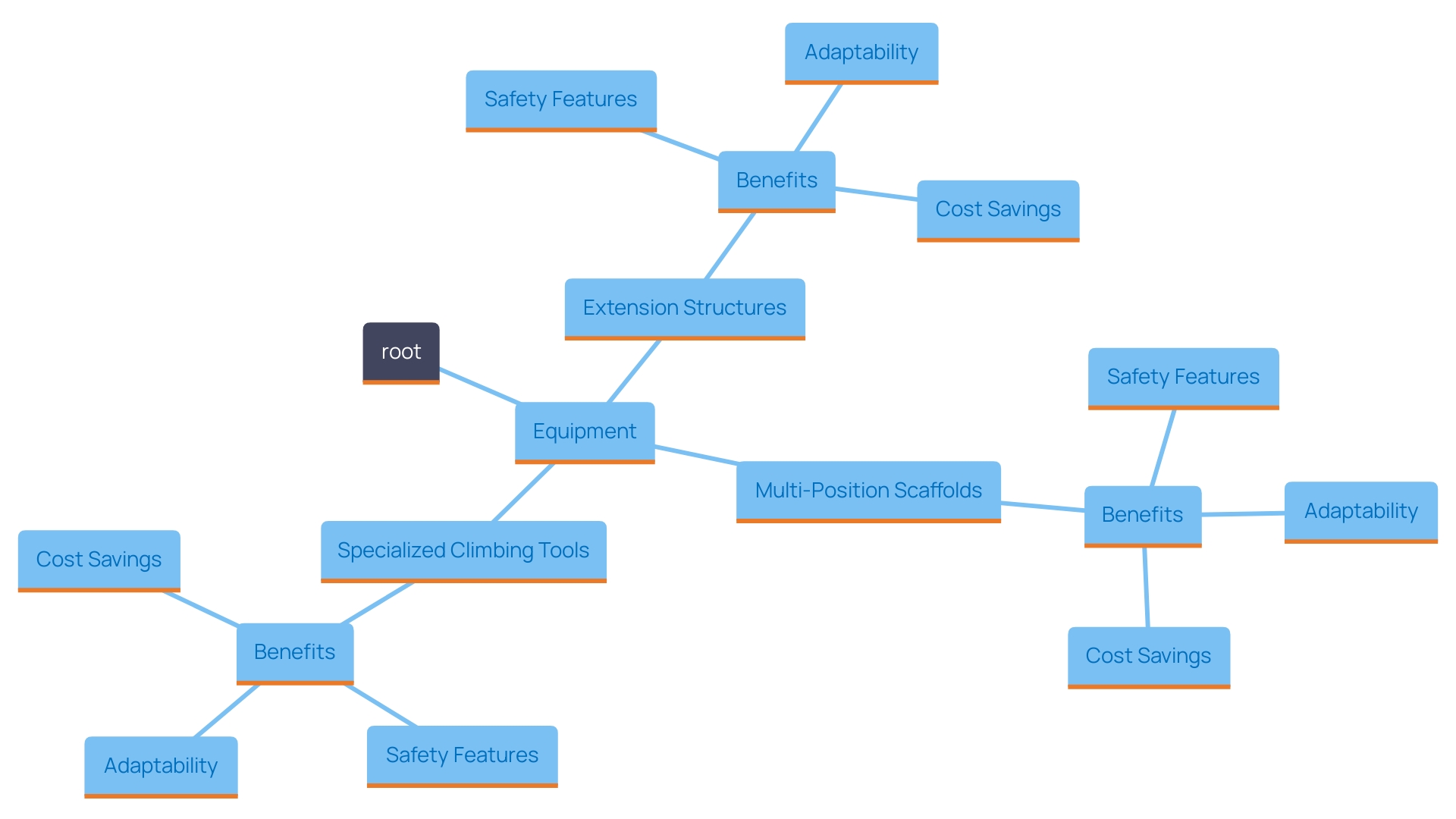
Evaluating Rental Providers and Agreements
Choosing the appropriate rental service is essential for guaranteeing a successful project. Begin by assessing the provider's reputation within the industry. Look for customer reviews and testimonials that highlight their service quality. Engaging with past clients or seeking recommendations can provide valuable insights into their reliability and customer support.
It's essential to consider the variety of products offered. An extensive selection enables you to pick the most appropriate step stool for your particular requirements, improving security and productivity at the work location.
When reviewing the rental agreement, pay close attention to the cost structure. Understanding all associated fees can help you stay within budget and prevent unforeseen expenses. Additionally, scrutinize liability coverage details; protecting yourself from potential accidents or damages is vital.
Maintenance responsibilities are another key aspect. Clarifying who is accountable for upkeep can prevent misunderstandings that could lead to project delays or additional costs. By thoroughly evaluating these elements, you can ensure a smooth rental experience, paving the way for the timely and successful execution of your construction tasks.
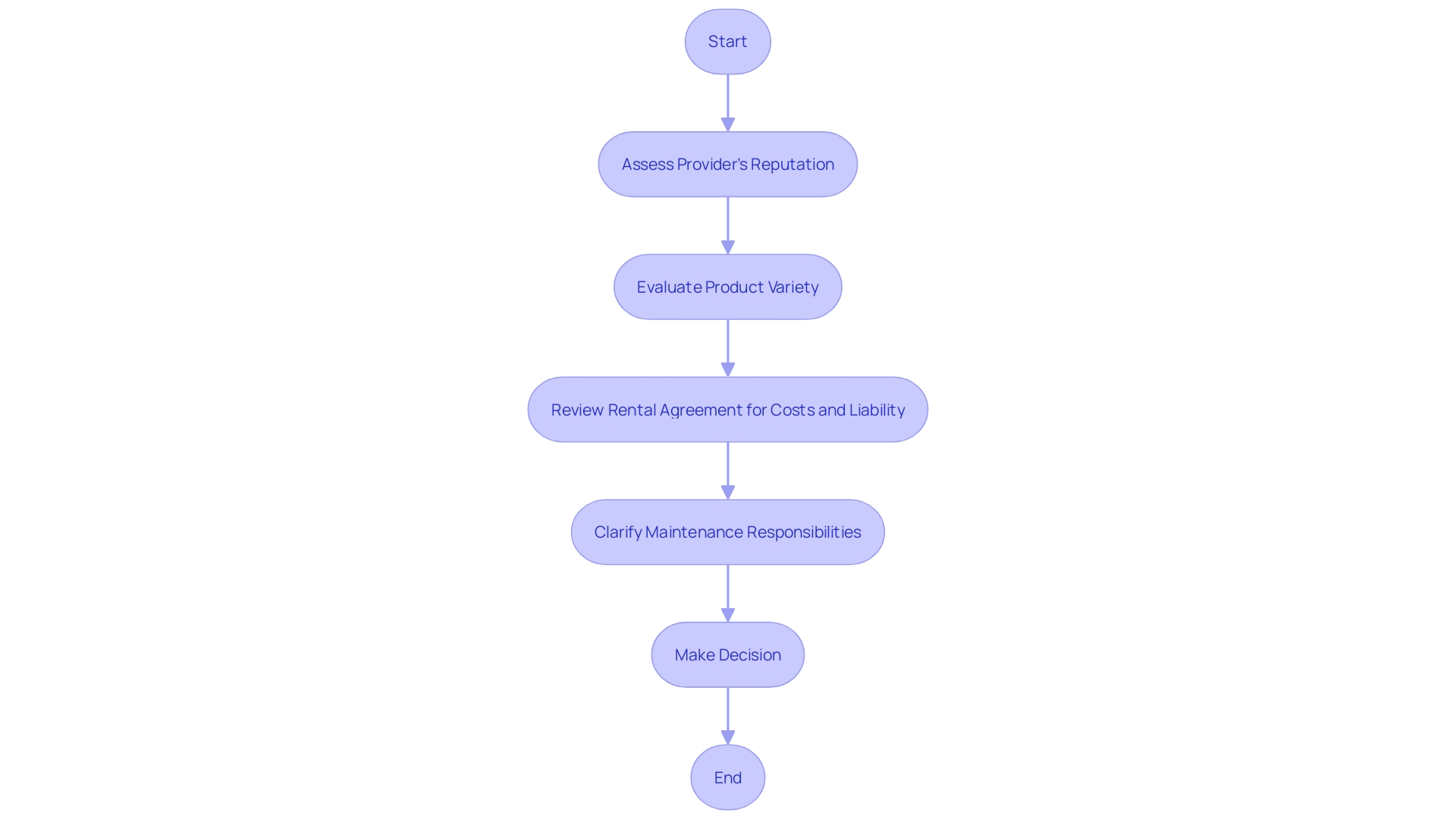
Best Practices for Using Rented Extension Ladders
Making certain of the secure and efficient utilization of rented extension equipment is crucial for both productivity and protection in different business activities. To achieve this, adhere to these best practices:
-
Proper Setup: Always position the ladder on a solid, level surface. This foundational step is crucial; a stable base prevents accidents and enhances overall well-being. As emphasized by industry experts, ensuring a secure setup can significantly reduce the risk of falls and injuries.
-
Secure Before Climbing: Once positioned, secure the equipment to prevent any movement while in use. Many contemporary extension devices come equipped with stabilizing features, such as non-slip feet and stabilizing bars, that enhance safety. These features are designed to provide additional support, making it easier to focus on the task at hand without worrying about potential instability.
-
Maintain Three-Point Contact: While ascending or descending, always maintain three-point contact. This means at least two hands and one foot, or two feet and one hand, are in contact with the climbing structure at all times. This practice is critical for maintaining balance and ensuring safety during climbs, as highlighted in safety training guidelines from organizations like OSHA.
-
After Use Care: Once your tasks are complete, clean the equipment thoroughly. This includes removing any dirt, debris, or substances that could compromise its integrity. Returning the climbing tool in the same condition as received not only helps avoid additional fees but also extends the life of the equipment.
By implementing these practices, businesses can improve security and maintain operational efficiency, especially in sectors requiring frequent height access, such as construction and maintenance. The investment in proper ladder usage pays off by reducing potential accidents and fostering a culture of safety within the workplace.
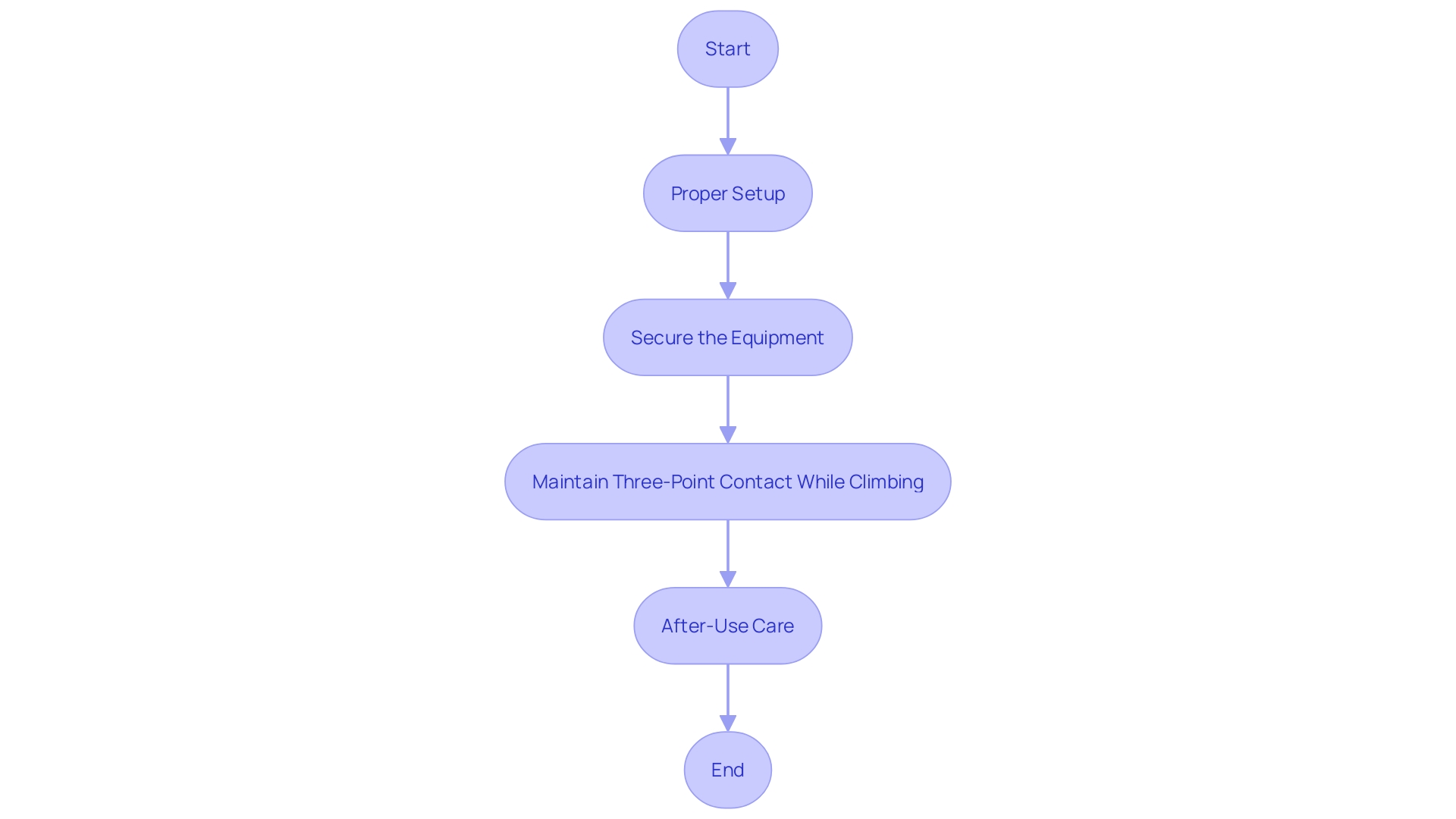
Conclusion
Selecting the appropriate extension ladder is crucial for enhancing safety and operational efficiency across various industries. Understanding the specific ladder types, such as extension and multi-position ladders, along with their applications, ensures that businesses can effectively meet the demands of their projects. Factors like height requirements, material differences, and safety features play a pivotal role in making informed choices that not only safeguard workers but also improve productivity.
When considering renting extension ladders, evaluating key aspects such as size, weight capacity, and additional safety features is essential. Renting provides flexibility and cost-effectiveness, allowing businesses to access high-quality equipment without the burdens of ownership. Moreover, establishing a solid relationship with a reputable rental provider can streamline processes and ensure compliance with safety regulations.
Adhering to best practices for ladder use is vital for minimizing risks associated with working at height. This includes proper setup, securing the ladder, maintaining three-point contact, and ensuring thorough post-use care. By implementing these practices, businesses can foster a culture of safety, reduce the likelihood of accidents, and ultimately enhance operational capabilities.
In summary, whether renting or purchasing, making informed decisions about extension ladders can significantly impact the safety and efficiency of operations. By prioritizing the right equipment and adhering to best practices, organizations can effectively navigate the challenges associated with working at height, ensuring that projects are completed safely and successfully.




